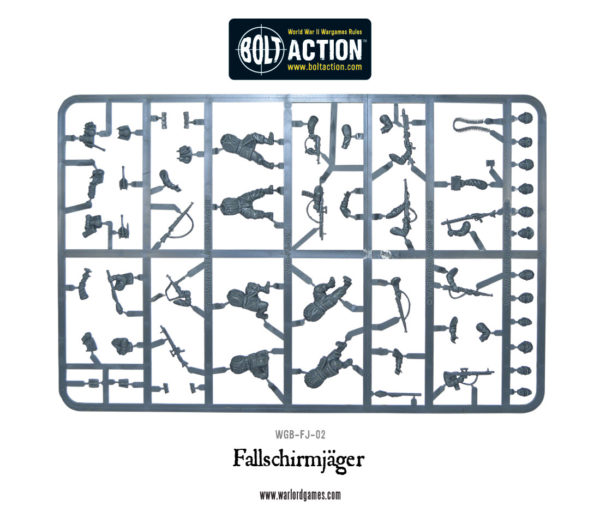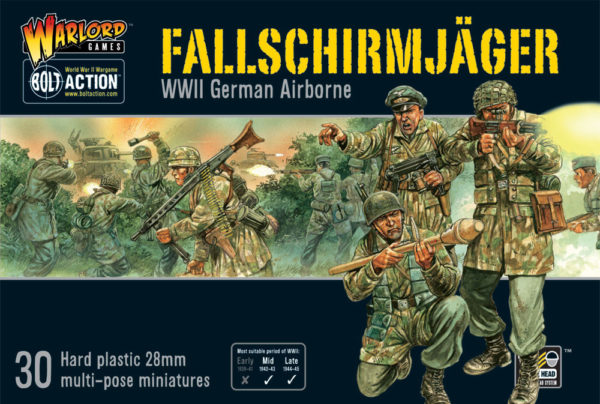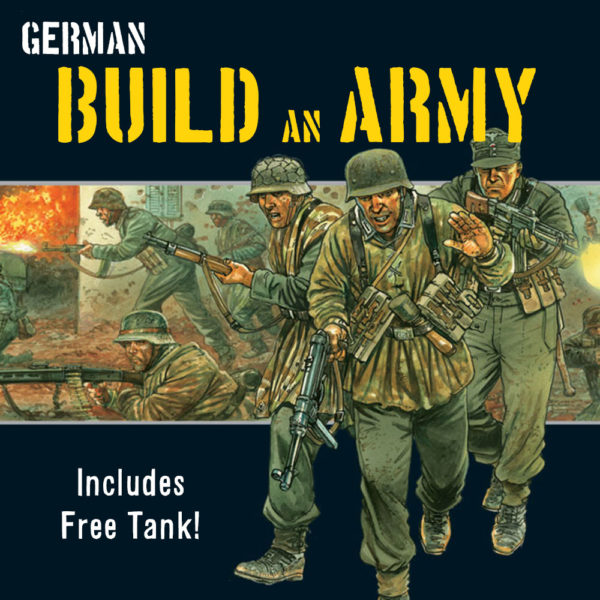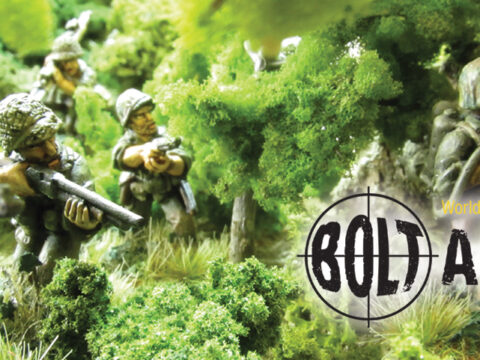This article by Mark Barber explains how to go about fielding a Bolt Action force entirely made of one specialized unit, like Commandos, Cavalry or indeed Paratroopers.
Mark has done his research thoroughly and then created a platoon selector and some special rules that allow all of the infantry in the platoon to share the special rules normally unique to the Fallschirmjäger infantry sections. Something you can do with any specialized force, creating your own special platoons.
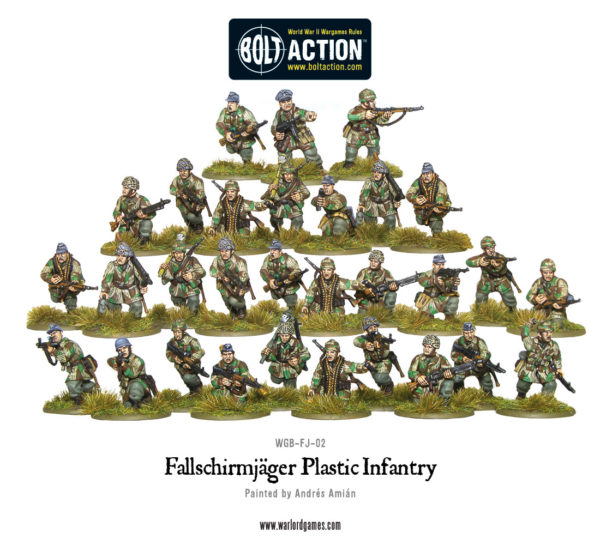
Worn boots crunched audibly into the snow as ranks of armed men advanced cautiously westwards. With temperatures of around 20 degrees below zero and some three feet of snow, this was one of the most severe winters in recorded history. Some soldiers remembered being part of a pioneering fort assault not far from here some four years ago; others remembered the warm, Mediterranean air rushing past them as they flung themselves out of a Junkers Ju52 in a Cretean summer; others still thought of even harsher conditions hundreds of miles to the east. Some of the most experienced officers and NCOs remembered all three campaigns firsthand. The ebb and flow of the fortunes of this elite unit echoed their very nation itself; once spearheading entire campaigns, the veteran Fallschirmjäger now found themselves advancing slowly and uncomfortably alongside their conventional infantry brethren…
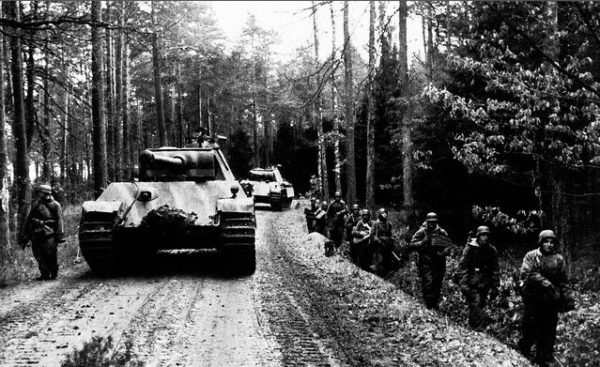
In December 1944, German forces swept across the snowy plains and forests of the Ardennes in one last, massive assault against the Western allies in what would become known as the Battle of the Bulge. Whilst many Fallschirmjäger were experienced by years of warfare, this was far from true for every unit which wore the coveted parachutist’s badge: at the southern end of the German 7th Army’s thrust on December 16th was the 5th Fallschirmjäger-Division. One battalion in the 13th Fallschirmjäger-Regiment had 12 officers with no combat experience, the majority of its 700 soldiers were aged sixteen or seventeen and its commanding officer described its NCOs as ‘willing but inept.’
Yet, although facing more experienced US soldiers and suffering massive casualties to their already inexperienced leadership in the opening rounds, the soldiers of the 5th Fallschirmjäger-Division would be at the forefront of the initial German assault and the notorious bloodbath that would erupt in and around the city of Bastogne. Although receiving little training compared to their comrades from only a few years earlier, the new fighters of the Fallschirmjäger had a reputation to maintain – a reputation as Germany’s elite – and under no circumstances was that reputation to be tarnished. In the Ardennes in 1944, they gave as good a fight as they ever had.
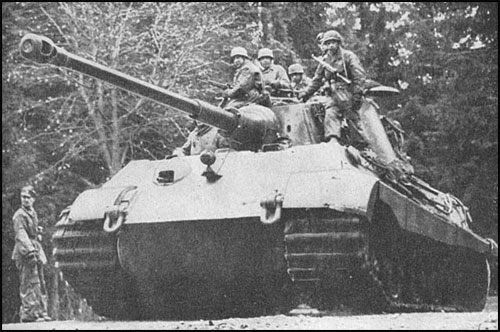
So who were the Fallschirmjäger and what had caused the fall from being one of the world’s most elite combat units to barely trained line infantry herded into battle?
First and foremost, the soldiers of the Fallschirmjäger were part of the Luftwaffe; this meant that unlike the British paratroopers and US Airborne who they would later face, they were air force men and not part of the army. During the interwar period, the Soviet and Italian militaries began to experiment with the concept of using parachutes to deploy a military force. Herman Goering witnessed Soviet military maneuvers involving the use of paratroopers in 1931 and 1935 and was inspired by their potential. Still bound by the constraints of the Treaty of Versailles, Germany was only able to build and modernize its meager military resources in secret. With this in mind, Goering established a parachute unit with his elite ‘General Goering’ police regiment. By 1938 he had 600 trained parachutists and transferred them to the embryonic Luftwaffe to form the first battalion of Fallschirmjäger.
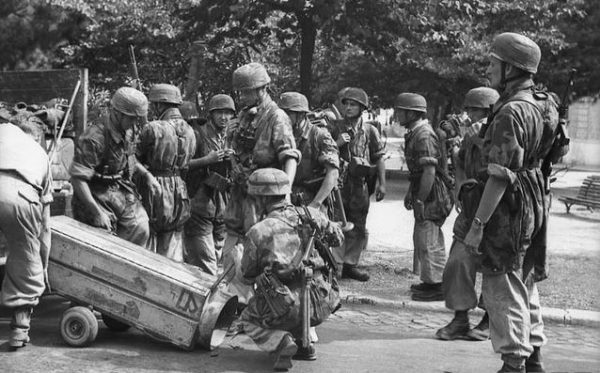
But this would not be enough. As Germany geared up for war, the idea of parachuting elite soldiers ahead of the main body of Germany’s assault force to capture key defenses was seeming more and more viable. An active recruitment drive for volunteers for the new paratroop force was initialized, resulting in scores of young men from not only the air force, but also the army and navy signing up. New recruits were selected not only based on their physical fitness; those who became airsick or were afraid of heights were quickly weaned out and even many who would have made fine paratroopers were also declined simply due to being too heavy for a parachute.
The eight weeks of basic training for new recruits was tough, even for those with an infantry background. Much emphasis was placed on physical fitness, unarmed combat and core military skills, but soldiers were now taught how to operate a variety of weaponry rather than just the rifle that they were already familiar with – including foreign weapons. Gymnastics and trampoline exercises eased the transition to the next stage of training: the sixteen day jump course. After six successful jumps, the recruits were presented their Parachutist’s Badge – the silver and gold Fallschirmschützenabzeichen – before their passing out parade and promotion to Oberjäger. Now the front line awaited.
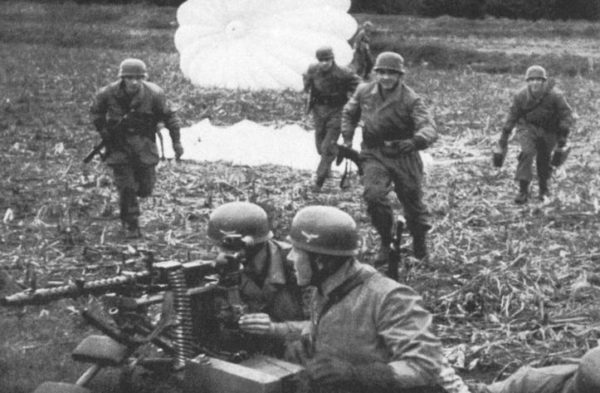
Army List – Early War Fallschirmjäger Parachute Assault Force
‘Armies of Germany’ gives rules for early war Fallschirmjäger to be used as part of an early war German army. Presented here is an army list which can be used to represent a purely Fallschirmjäger strike force which would have been deployed ahead of a main advance to take key objectives. Fallschirmjäger could be deployed by glider or static line jumping and, as a result, force composition for this highly flexible unit was variable to say the least. This has resulted in several primary sources presenting conflicting information.
This army list represents a Ju52 deployed Fallschirmjäger force which would have been dropped by parachute, based on information presented in Osprey’s Battle Order: German Airborne Divisions 1940-41 by Bruce Quarrie. This saw sections based on 12 man units based on the troop carrying capacity of the Junkers Ju52. The early war Fallschirmjäger featured in Armies of Germany are far better suited for a player wishing to base his force around a force of Fallschirmjäger deployed by gliders.
New Units:
Early War Fallschirmjäger (Parachute Deployed)
Cost: Veteran Infantry 78 pts
Composition: 1 NCO and 5 men
Weapons: Rifles
Options:
– Add up to 6 additional men with rifles at +13pts each.
– The NCO and up to 1 man can have submachine guns instead of rifles for +3pts each.
– Up to 1 man can have a light machine gun for +20pts – another man becomes the loader.
– The squad can be given pistols at +1pts per man.
– The squad can be given anti-tank grenades for +2pts per man.
Special Rules:
– Tank hunters (if anti-tank grenades taken)
Early War Fallschirmjäger Mörsertrupp
Cost: 46pts (Veteran)
Team: 2 men
Weapons: 1 light mortar
Options:
– Add up to 3 additional men with rifles at +13pts each.
– Up to 3 men can have submachine guns instead of rifles for +3pts each.
– The squad can be given pistols at +1pts per man.
Special Rules
– Team weapon
– Indirect fire
– HE (D3)
Para-Dropped Fallschirmjäger Strike Force 1940-41 Reinforced Platoon
1 Veteran Leutnant or Oberleutnant*
2 Early War Fallschirmjäger (Parachute Deployed) squads
plus:
Headquarters
0-1 Veteran Oberleutnant, Hauptmann or Major
0-1 Medic
Infantry
0-4 Infantry Squads: Early War Fallschirmjäger (Parachute Deployed)
0-2 Mortar Teams: Early War Fallschirmjäger Mörsertrupp
Special Rules:
* Whilst officially a Fallschirmjäger platoon was led by a Leutnant, we have also allowed an Oberleutnant to be included as an option. As highlighted on P.62 of the rulebook, linking morale bonuses to ranks is merely a gameplay convention and so the inclusion of an Oberleutnant is representative of a more experienced Leutnant.
– Pistols: a parachutists deploying directly into combat is vulnerable, to say the least. A rifle or submachinegun could easily become caught or entangled before a paratrooper could extricate himself from his harness after landing. With this in mind, early war Fallschirmjäger carried pistols when deploying by parachute. Any individual in a Para-Dropped Fallschirmjäger Strike Force 1940-41 Reinforced Platoon can be equipped with a pistol at +1pts per man, even if their basic rules do not normally allow it.
– Combined HQ: With the composition of the force based around the carrying capacity of the Ju52, small units were often amalgamated for transport. Whilst in practice medics would often be dispatched to wherever needed, the actual organizational structure placed them in their Platoon and Company HQs. Therefore, a Para-Dropped Fallschirmjäger Strike Force 1940-41 Reinforced Platoon may combine its medic unit with the platoon Leutnant or company officer (Oberleutnant, Hauptmann or Major) to form one unit which combines the benefits of officer leadership bonuses and medic saves.
Army List – Late War Fallschirmjäger Infantry Force
By the closing stages of the war Germany was on the defensive and there was no scope for aggressive, large-scale parachute drops or glider assaults. The majority of the Fallschirmjäger were deployed as conventional – albeit elite – infantry units on the front line, facing both the advancing Soviet forces and western allies. Still lavishly equipped by the Luftwaffe, they saw a greater concentration of machine guns at both platoon and company level than their Heer counterparts, and also a dedicated Anti-tank Troop equipped with panzerschreks. The army list here may be used to represent a Fallschirmjäger force deployed in the role from the end of 1944 through to Germany’s defeat, together with artillery and armour support.
New Units and Equipment:
Green Fallschirmjäger Squad (Late-War)
These soldiers represent the hurriedly recruited and trained teenagers who were rushed to the front line to bolster the ranks of the Luftwaffe’s elite fighting force. Options for Green Fallschirmjäger are the same as for Fallschirmjäger Squad (Late-War) as detailed on P.24 of ‘Armies of Germany.’ However, rather than being Veteran Infantry, the squad is Inexperienced and Green. Therefore, the 1 NCO and 4 men cost 35 pts and the addition of up to 5 further men with rifles cost 7 points each. In all other respects, their options and equipment are the same as for Fallschirmjäger Squad (Late-War).
Gewehrgranatengerät Grenade Launcher:
This cup like device was introduced in 1942 to allow the German infantryman to fire grenades directly from his rifle with a range in excess of when thrown manually. It could be attached to a variety of weapons, including the Kar98, StG44 and FG42.
Weapon Type Range Shots PEN Special Rules
Gewehrgranatengerät Launcher 6-18” 1 HE Indirect Fire, HE (D2)
Late War Fallschirmjäger Reinforced Platoon
1 Leutnant or Oberleutnant
2 Fallschirmjäger (Late-War) squads; veteran or green
plus:
Headquarters
0-1 Hauptmann or Major
0-1 Medic team
0-1 Forward Observer (either Artillery or Air)
Infantry
0-4 Infantry Squads: Fallschirmjäger (Late-War) squads; veteran or green
0-3 MMG teams
0-1 Mortar Team: light or medium
0-2 Panzerschrek teams
0-1 Sniper team
0-1 Flamethrower team
Artillery
0-1 gun from:
Anti-tank gun: PaK 40, PaK 43
Artillery gun: Light, Medium, Heavy or 150mm Nebelwerfer
Anti-aircraft gun: Flak 38, Flakvierling 38, Flak 36 or 88mm AA/AT Flak 36
Armoured Cars
0-1 Armoured Car or Recce vehicle: SdKfz 222, SdKfz 234/1, SdKfz 234/2 Puma, SdKfz 234/3, SdKfz 250/9, SdKfz 250/10 or SdKfz 250/11
Tanks, Tank Destroyers, Assault Guns, Self-propelled Artillery and Anti-Aircraft Vehicles
0-1 vehicle from: Panzer II Ausf L, Panzer IV Ausf H or J, StuG III Ausf F, G or H, StuG IV, StuH42, Marder III Ausf H or M, Panther Ausf A or G, Tiger I, Tiger II, Grille, Wespe, Hummel, SdKfz 251/2, SdKfz 250/7, Jagdpanzer IV, Hetzer, Brummbar, Sturmtiger, Jagdpanther, SdKfz 251/9 Stummel, SdKfz 251/16 Flammpanzerwagen, SdKfz 251/17, SdKfz 250/8 Stummel, SdKfz 10/4 with Flak 38, SdKfz 7/1 or 7/2, SdKfz 7/2 armoured cab, Flak Panzer 38(t), Mobelwagen, Wirbelwind, SdKfz 251/22 Pakwagen, SdKfz 251/1 Stuka zu Fuss
Transports and Tows
0-1 Transport vehicle per infantry in the reinforced platoon from: SdKfz 10, SdKfz 7, Truck, Maultier, Kubelwagen, Schwimmwagen, SdKfz 251/1, SdKfz 250/1, Heavy Field Car, a maximum of one SdKfz 251/10
0-1 Tow from: SdKfz 10, SdKfz 7, Truck, Maultier, SdKfz 4, Raupenschlepper Ost, Kettenkrad, Heavy Field Car
Special Rules:
– Combined HQ: The early war practice of combining larger HQ units for ease of transportation was still present in late war Fallschirmjäger platoons. Whilst in practice medics would often be dispatched to wherever needed, the actual organizational structure placed them in their Platoon and Company HQs. Therefore, a Late War Fallschirmjäger Reinforced Platoon may combine its medic unit with the platoon Leutnant or Oberleutnant or company officer (Hauptmann or Major) to form one unit which combines the benefits of officer leadership bonuses and medic saves.
– Gewehrgranatengerät: any Fallschirmjäger (Late-War) squads (veteran or green) may add up to 2 Gewehrgranatengerät for +20 pts each. They may be added to any model with a rifle or assault rifle and can be fired instead of the model’s main weapons, not in addition.
